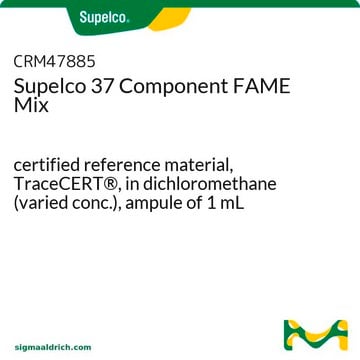52619
Hexamethyldisilazane
for GC derivatization, LiChropur™, ≥99.0% (GC)
Sinônimo(s):
HMDS
About This Item
Produtos recomendados
grau
for GC derivatization
Nível de qualidade
Ensaio
≥99.0% (GC)
Formulário
liquid
qualidade
LiChropur™
adequação da reação
reagent type: derivatization reagent
reaction type: Silylations
técnica(s)
gas chromatography (GC): suitable
índice de refração
n20/D 1.407 (lit.)
n20/D 1.408
p.e.
125 °C (lit.)
cadeia de caracteres SMILES
C[Si](C)(C)N[Si](C)(C)C
InChI
1S/C6H19NSi2/c1-8(2,3)7-9(4,5)6/h7H,1-6H3
chave InChI
FFUAGWLWBBFQJT-UHFFFAOYSA-N
Procurando produtos similares? Visita Guia de comparação de produtos
Categorias relacionadas
Descrição geral
Aplicação
It may be used as a derivatizing reagent for the analysis of bioamines and their acidic metabolites,[3] phenol, hydroquinone and catechol[4] in urine samples, mixtures of free fatty acids and metal soaps in paint samples[5] using gas chromatography/mass spectrometry (GC/MS).
Características e benefícios
- HMDS is inexpensive and has a relatively low boiling point (124-127 °C).
- It can be used without solvent but its silylating power can be increased by various (mostly acidic) catalysts.
- The only reaction byproduct, ammonia, can leave the reaction mixture as the reaction goes to completion.
Outras notas
Informações legais
Palavra indicadora
Danger
Frases de perigo
Declarações de precaução
Classificações de perigo
Acute Tox. 3 Dermal - Acute Tox. 4 Inhalation - Acute Tox. 4 Oral - Aquatic Chronic 3 - Flam. Liq. 2
Código de classe de armazenamento
3 - Flammable liquids
Classe de risco de água (WGK)
WGK 2
Ponto de fulgor (°F)
52.5 °F - closed cup
Ponto de fulgor (°C)
11.4 °C - closed cup
Equipamento de proteção individual
Faceshields, Gloves, Goggles, type ABEK (EN14387) respirator filter
Escolha uma das versões mais recentes:
Já possui este produto?
Encontre a documentação dos produtos que você adquiriu recentemente na biblioteca de documentos.
Artigos
Results of a study involving the ability few Fluka silylating reagents to form GC-MS-compatible trimethylsilylmethyl derivatives of NSAIDs
Active Filters
Nossa equipe de cientistas tem experiência em todas as áreas de pesquisa, incluindo Life Sciences, ciência de materiais, síntese química, cromatografia, química analítica e muitas outras.
Entre em contato com a assistência técnica






